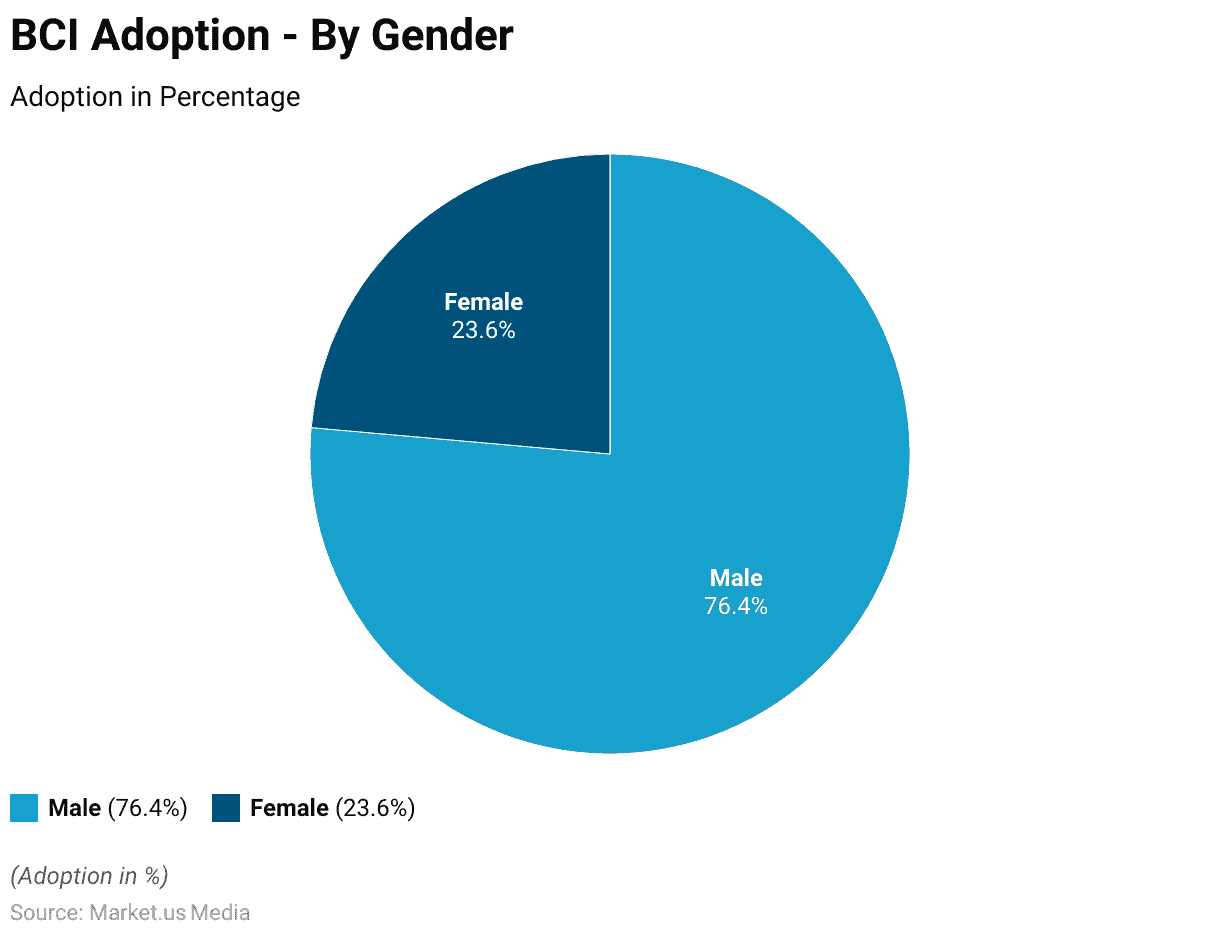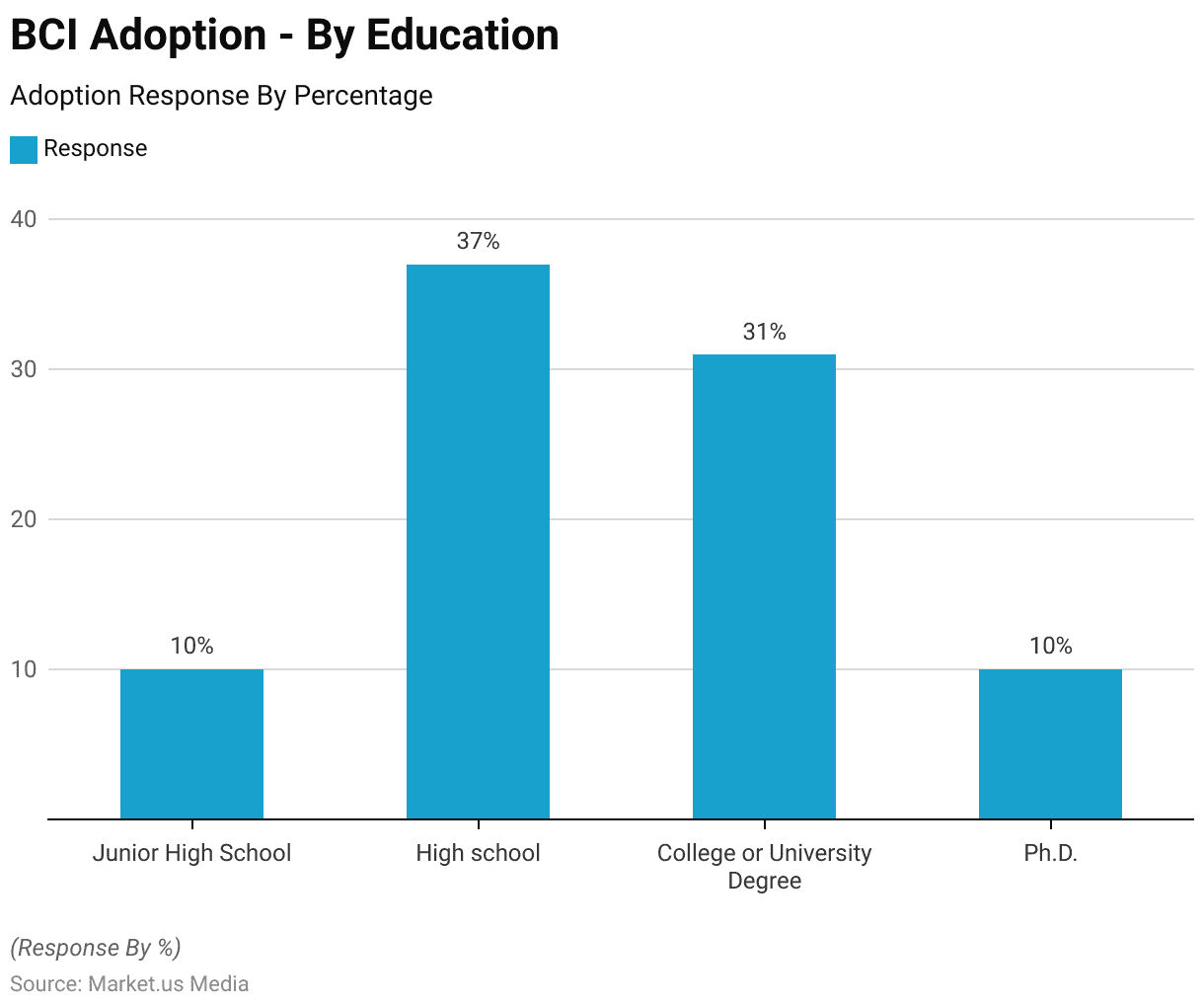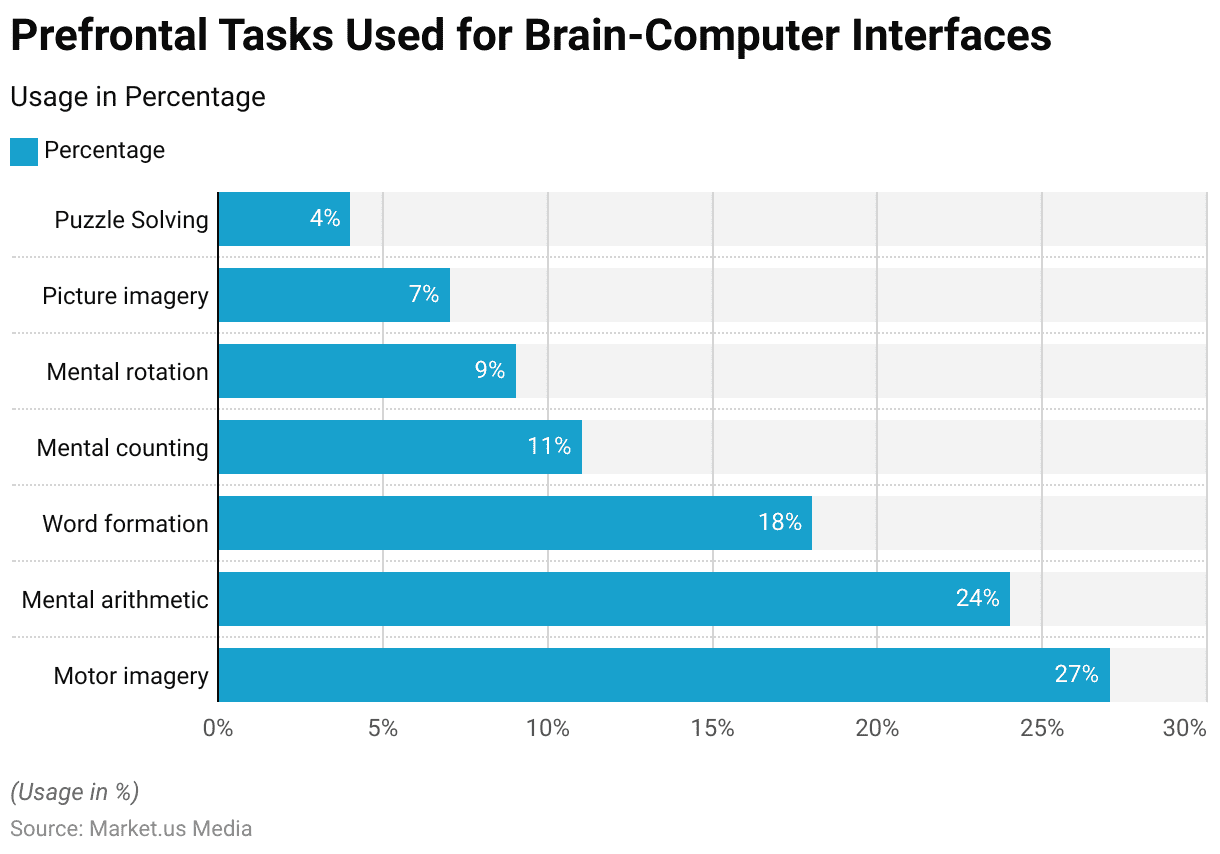Table of Contents
- Introduction
- Editor’s Choice
- Brain-Computer Interface Market Overview
- Demographics of Brain-Computer Interface
- Brain-Computer Interface Investment Statistics
- Prefrontal Tasks Used for Brain-Computer Interfaces
- Popular Brain-Computer Interfaces
- Research & Development in Brain-Computer Interface
- Recent Trends in BCI Technology
Introduction
According to Brain-Computer Interface Statistics, A Brain-Computer Interface (BCI) is a technology that connects the human brain to external devices, enabling direct communication without physical inputs.
BCIs have diverse applications, including aiding individuals with disabilities, enhancing human capabilities, and advancing research. They come in various forms, from non-invasive methods like EEG and fNIRS to invasive implants.
BCIs decode brain signals using advanced algorithms, facilitating control of computers, robots, or communication devices. However, challenges such as signal accuracy and ethical concerns about privacy and consent remain.
Despite these challenges, BCIs hold promise for healthcare, gaming, and education, with ongoing research aimed at their improvement.
Editor’s Choice
- The Brain-Computer Interface (BCI) market has been experiencing remarkable growth at a CAGR of 15.7%
- In 2022, the BCI market generated approximately USD 1,790.1 million in revenue.
- The North American region is at the forefront of the global brain-computer interface (BCI) market, holding a significant share of 40.2% in terms of revenue.
- Among BCI users, males represent a substantial majority at 76.4%, while females account for the remaining 23.6%.
- Among BCI users, 37% have a high school education, while 31% hold a college or university degree.
- Among prefrontal tasks, motor imagery stands out as the most commonly utilized in BCI, accounting for 27% of task usage.
- More recently, Elon Musk’s Neuralink revealed a substantial series C funding round totaling an impressive $205 million.

Brain-Computer Interface Market Overview
Global Brain Computer Interface Market Size
- The Brain-Computer Interface (BCI) market has been experiencing remarkable growth at a CAGR of 15.7%, with revenues steadily increasing over the coming years.
- In 2022, the market generated approximately USD 1,790.1 million in revenue.
- This growth trajectory is expected to continue, reaching an estimated USD 3,321.7 million in 2026, USD 3,775.7 million in 2027, and USD 4,140.7 million in 2028.
- As we move towards the end of the decade, the BCI market is forecasted to expand even further, with anticipated revenues of USD 4,790.8 million in 2029, USD 5,445.6 million in 2030, and an impressive USD 6,300.6 million in 2031.
- The growth momentum is expected to persist, reaching an estimated USD 7,419.0 million in 2032.

Global Brain Computer Interface Market Size- By Component
- The global Brain-Computer Interface (BCI) market has shown significant growth over the years, driven by increasing demand for advanced brain-computer interaction technologies.
- In 2022, the total revenue for the BCI market reached approximately USD 1,790.1 million.
- This revenue is divided into hardware and software components, with hardware contributing USD 1,159.98 million and software generating USD 630.12 million.
- The subsequent years continue to reflect this growth trend, with projected total revenues of USD 2,071.1 million in 2023, USD 2,354.2 million in 2024, and USD 2,820.9 million in 2025.
- The hardware segment consistently outpaces software, indicating a strong demand for BCI hardware solutions.
- By 2032, the BCI market is anticipated to reach an estimated USD 7,419.0 million in total revenue, with hardware accounting for USD 4,807.51 million and software contributing USD 2,611.49 million.
Regional Analysis of the Global Brain Computer Interface Market
- The North American region is at the forefront of the global brain-computer interface (BCI) market, holding a significant share of 40.2% in terms of revenue.
- This substantial growth in North America is primarily due to the advanced technological infrastructure found in countries such as the United States and Canada.
- Following North America, the Asia Pacific region is poised to experience the highest Compound Annual Growth Rate (CAGR) during the forecast period.
- The Asia Pacific region is expected to witness significant growth due to increased awareness among patients and a rise in healthcare spending in countries like China, Japan, and South Korea.
Demographics of Brain-Computer Interface
According to Gender
- When considering Brain-Computer Interfaces (BCI) and their usage, there is a notable gender distribution.
- Among BCI users, males represent a substantial majority at 76.4%, while females account for the remaining 23.6%.
- This gender disparity in BCI usage may reflect broader trends in technology adoption, with males being more represented in this particular field.

According to Education
- In the realm of Brain-Computer Interfaces (BCI), user demographics based on educational backgrounds reveal interesting patterns.
- Among BCI users, 37% have a high school education, while 31% hold a college or university degree.
- Furthermore, 10% of BCI users possess a PhD, indicating a significant level of education among a segment of the user base.
- Interestingly, 10% of users have completed junior high school, suggesting that BCIs have some accessibility and utility for individuals with varying educational backgrounds.

Brain-Computer Interface Investment Statistics
- In May 2021, Peter Thiel and re. Mind Capital made a significant investment of $10 million into Blackrock Neurotech.
- More recently, Elon Musk’s Neuralink revealed a substantial series C funding round totaling an impressive $205 million.
- Vy Capital led this funding round, with notable participation from Valor Equity Partners, Google Ventures, DFJ Growth, Craft Ventures, Founders Fund, and Gigafund.
- When you consider the substantial combined investments of $70 million across Synchron, Paradromics, and Blackrock, it’s evident that there is a sustained and strong interest in implantable devices focused on improving signal acquisition.
- For instance, Paradromics secured $20 million in seed funding, led by Prime Movers Lab, with contributions from Synergy Ventures, Westcott Investment Group, Pureland Global Venture, Dolby Family Ventures, IT-Farm, and Alpha Edison.
- Their flagship product, the Connexus Communication Device, aims to restore communication for individuals who have lost their ability to speak due to severe paralysis.
Prefrontal Tasks Used for Brain-Computer Interfaces
- In the realm of Brain-Computer Interfaces (BCIs), various prefrontal tasks are employed to facilitate effective communication between the human brain and external devices or systems.
- These tasks serve as the means through which users can convey their intentions or commands.
- Among these prefrontal tasks, motor imagery stands out as the most commonly utilized, accounting for 27% of task usage.
- Following closely behind is mental arithmetic at 24%, followed by word formation at 18%.
- Mental counting and mental rotation tasks contribute 11% and 9%, respectively, to the BCI landscape.
- Picture imagery and puzzle-solving tasks, while less prevalent, still play a role, comprising 7% and 4% of the task distribution, respectively.

Popular Brain-Computer Interfaces
BCI2000
- BCI2000 is a versatile platform for data acquisition, brain signal processing, and research tasks.
- It stores data in standard formats (BCI2000 native or GDF) with event markers and system configurations.
- BCI2000 provides tools for easy data import/export, including direct loading into Matlab and exporting to ASCII.
- BCI2000 seamlessly integrates with other software; you can run real-time Matlab scripts or compile BCI2000 filters into standalone programs.
- It offers a user-friendly network interface for interaction with external programs in any language.
BSanalyze
- BSanalyze is an interactive platform designed for processing and analyzing multimodal biosignal data, particularly in life sciences.
- With a history spanning over two decades and a presence in more than 70 countries, it is celebrated as the most comprehensive software for investigating both invasive and non-invasive functions of the brain, heart, and muscles, including various disorders.
- It has received numerous international awards. The latest version brings several enhancements, including features like topographic plots, Cortio-Cortical Evoked Potentials, CCA, new filtering options, a cortiQ file importer, Result2D updates, an ECoG toolbox, a TMS toolbox, and more.
BCILAB
- BCILAB stands as a MATLAB toolbox tailored for Brain-Computer Interface (BCI) research.
- It simplifies the process of conceiving and crafting novel approaches for estimating cognitive states, enabling their application in both offline data analysis and real-time scenarios.
- BCILAB boasts an expandable repository comprising over 100 methods drawn from the existing literature, encompassing signal processing, machine learning, and BCI-specific techniques.
OpenViBE
- OpenViBE serves as a specialized software platform dedicated to the creation, experimentation, and utilization of brain-computer interfaces (BCIs).
- This software is designed for real-time neuroscience applications, enabling the live processing of brain signals.
- Originating in 2006 within the realm of biology and healthcare, OpenViBE boasts a user-friendly interface that simplifies the creation and preservation of BCI scenarios for future use, making them easily accessible and manipulable.
- Notably, it represents the inaugural library of C++ functions of its kind, developed by INRIA (Institut National De Recherche En Informatique Et Automatique) in France, facilitating seamless integration and application.
BioSig
- Biosig offers a comprehensive set of tools tailored for the processing of various biomedical signals, including electroencephalograms (EEG), electrocardiograms (ECG), electrooculograms (EOG), electromyograms (EMG), and more.
- These tools encompass a wide range of functions, such as artifact handling, quality control, time series analysis, feature extraction, classification, machine learning, and statistical analysis.
- One notable feature is its ability to work with data containing missing values, making it suitable for tasks like statistics, time series analysis, and machine learning.
- Biosig also boasts support for over 40 different data formats and includes converters for ECG, EEG, and polysomnography data.
Research & Development in Brain-Computer Interface
- In the field of Brain-Computer Interfaces (BCI), research collaborations are primarily concentrated in the United States and China.
- Notably, Tianjin University and the University of California, San Francisco (UCSF), are prominent and active contributors to this field.
- An especially noteworthy publication is the patent from UCSF, identified as CA2886095A1, titled “Systems and methods for sensory and cognitive profiling,” with an estimated value of approximately $2.34 million.
- This patent encompasses techniques, devices, and systems designed for the creation of cognitive and/or sensory profiles.
Recent Trends in BCI Technology
- When examining companies established in the last decade, we observe some of the most active entities in terms of patent filings.
- Among these, Cognixion, a computer software company specializing in artificial intelligence, machine learning, and biotechnology, has secured significant funding, with approximately $15 million, including recent backing from the Amazon Alexa Fund.
- Cognixion’s software incorporates a sensory communication system that empowers individuals to communicate through a Brain-Computer Interface (BCI), translating brainwave signals directly into communication.
- Another noteworthy startup is Neuralink, founded by Elon Musk and widely recognized in this field.
Discuss your needs with our analyst
Please share your requirements with more details so our analyst can check if they can solve your problem(s)



